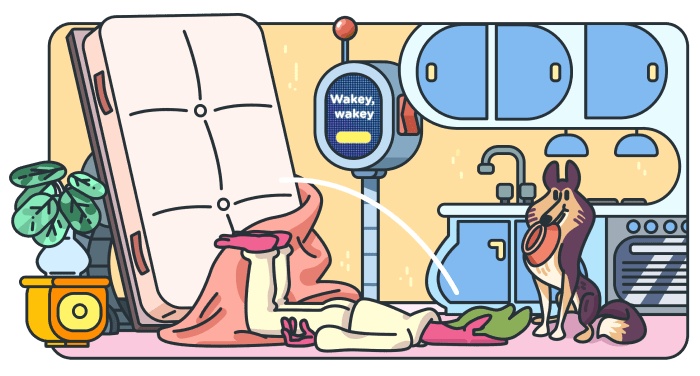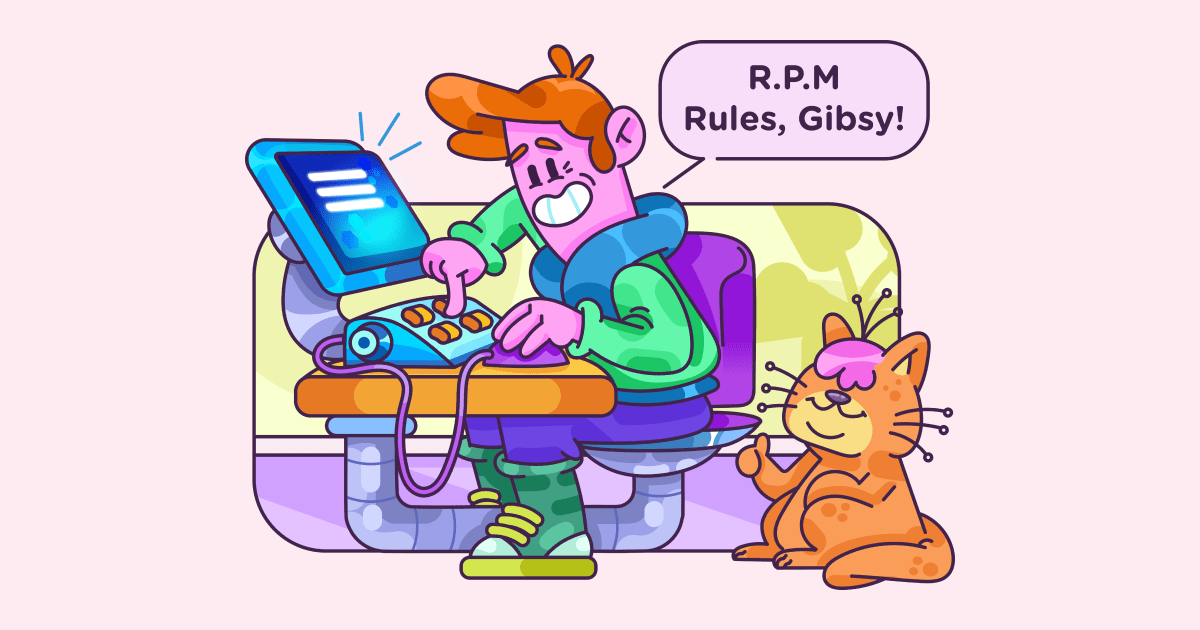The secrets of a productive morning routine
Last updated on: June 29, 2023
How often do you take the time to sit in your bed and let your mind slowly wake up? Or do you jump at the first ring of the alarm? Or snooze the alarm and hate yourself as you barely drag yourself out? There is no perfect way to start the day, we’ll always prefer lazing about just a little more. But, with just a little bit of effort, you can significantly improve your mood and prepare for the day ahead, no matter what is in store.

Table of Contents
Why morning routines are necessary for productivity
Morning routines are the single best form of self-care, and you need one in place to give your mind some time to wake up. Those who condense their routine into 20-30 minutes before heading off to work are undoubtedly doing it all wrong. It’s too quick of a jumpstart to your morning: your body is already in action, while the mind is playing catch-up. No wonder many people feel groggy and grouchy, fully waking up only several hours into work.
Having a routine in place gives your mind the much needed boost before an activity-packed day. So, learning how to wake up your brain effectively will first and foremost boost your mood. And the rest will follow along (productivity, efficiency, etc).
Start your planning around the time you start work
Instead of throwing a wild guess by saying you’ll wake up at 6AM this time, plan your morning routine backwards.
- Consider what time you start work
- Consider commute times, and the necessary preparations before that (checking if you’ve brought everything, cleaning up after breakfast, etc)
- What remains between that and the hour you wake up should be your morning routine.
Luckily, how long the routine lasts can be arbitrary – so long as it’s more than 20 minutes.
Time how long it takes you to do each thing
You probably won’t have a perfect plan right away. Like all good things in life, it takes some time and practice to make the routine just right. What you can do to speed up this process is to track how much time you spend on each activity.
How long it takes you to brew coffee or tea, how long it takes you to get out of bed, do morning stretches, feed and walk the pets, and the rest. And if you have a general idea on their duration, even better! This will be a great opportunity to sort them in a specific order, and give them some structure.
Now, that alone isn’t enough. Another good thing is to step back and take a look at how you can make your morning routine better. The purpose is to wake up your brain, and start the day off in a great mood. And if your current routine isn’t cutting it, let’s take a look at some tried-and-true tips that could help.
Morning routine ideas
The following ideas come from personal experience, those of my friends and family, but also from days of researching the vastness that are productive morning routines. We’ll look at the advice itself, why it’s good for you, and if there are any alternatives with the same effect.
Take a slow start
One thing I have stuck to ever since my yearly physical exam in high school is spending a few minutes in bed before getting up. Back then, the doctor asked me about my sleeping and morning habits, to which I replied I usually get up as soon as I open my eyes, get ready for school and get out the door not 20 minutes after waking up. To which she replied I should absolutely stop doing that, and stay in bed for at least two or three minutes.
How it helps: What the doctor told me was simple and made a lot of sense – we spend at least five minutes getting ready for bed: shower, brush teeth, get in bed, and let our brains realize it’s time for bed. But we don’t do the same in the morning. So, the idea is to do a few stretches in bed, fully open our eyes, take a few deep breaths to let our bodies “boot up”.
Getting up immediately only shocks the system, forcing it to “boot up” as we task it with other things (like deciding what to wear, what to eat, or having early morning conversation, or worse – checking email). Hence most of us feel groggy, moody, and overwhelmed in the morning.
Alternatives: If laying in bed for a few minutes after waking up isn’t your thing, then sit up and stretch slowly, or sit off the side of the bed with your feet on the floor. Just don’t stand up immediately.
Walk the dog (or take a walk by yourself)
One of the first pieces of productivity advice you’ll find online is to take a morning walk as soon as you can. However, if you’re not the type who finds it easy to walk for no reason, then you need to find one. I, for example, have been pushed by circumstance into walking our puppy first thing in the morning (it having a small bladder and waking up with the first rays of sun).
How it helps: It’s a great substitute for morning workouts. It’s easy enough so that you can do it every day, and even just 20 minutes can wake you up and get you going. There’s no need to reiterate how good walks are for you: improved blood flow, increased focus, lowered stress, and building muscle. Plus, walking my dog, I get to take in the chill of the morning, how quiet the neighborhood is at that hour, and maybe we run into another dog to play with.
Alternatives: If you don’t have a dog to walk, try walking to the nearest coffee shop for a cup to go, or to the corner shop or the bakery for breakfast, or the newspaper. Just find a small reason to take a brief walk, and turn it into a pleasant waking up ritual.
Start with something you enjoy
Consider starting the day off by doing something you enjoy. This is to kick off your morning on a positive note. Whatever your hobbies include, try switching them from “after work” to “before work”. If you like to write, write a single page of a random scene, or just note down your thoughts. Draw a few sketches as you drink your morning coffee, browse your favorite app or play a video game (in short bursts, of course). All you need is 15-20 minutes of it.
How it helps: In order to be productive, you need to be mentally ready to tackle the day ahead. And if you wake up with the idea of work weighing on you, then you need to find an activity you’ll look forward to.
Morning news
Lately, we’ve seen that news can be the bearer of bad tidings, especially in the past few years. But, if you carefully curate the content you follow, it can be beneficial. To this day I remember school mornings that would start off with me walking into the living room as mom made coffee and the morning program was playing on TV. The weather forecast, city events, various guests, etc. Hearing the hosts just made the house seem more… alive, in a way.
How it helps: If you live alone, TV is great at being the white noise to fill up otherwise eerily quiet space. The same goes for your computer, phone, or tablet. Just by not using your earphones, and the sound coming from the speakers, you hear the hosts as if they are in the room with you. And the content keeps you updated, engaged, and makes the whole morning less lonely.
Alternatives: Play a music channel, listen to a podcast or the radio, play a YouTube video from a creator you like. Any kind of productivity podcast or channel that can kick your brain into gear is a great way to start the day right.
Do things with mindfulness
Mindfulness is the practice of staying present in the moment as you perform an activity. Therapists often use it to help their clients: usually through guided breathing exercises. The goal of these exercises is to ground people who have the habit of overthinking, or are unable to “get out of their own head” due to stress and anxiety.
You can introduce it into your morning routine even if you don’t have the above mentioned issues. It’s still a wonderful way to start the day focused and ready to tackle bigger challenges.
How it helps: It teaches your brain, day by day, to focus on the little things, instead of kicking off the day worrying over what’s to come.
Alternatives:
- Do a mindful breathing exercise – as you inhale deeply, focus on feeling the air traveling down to your lungs, and as you exhale. Pay attention to your stomach rising and falling as you breathe. Do this for one minute.
- As you make breakfast or coffee – take your time, and observe the details, like the color of your crockery, the smell of food or the brewing drink, the heat on your hands, etc.
- Outside noises and sights – what is happening outside your living space? Listen to the traffic, the children going to school, people passing by, the weather and animals,…
Create a morning playlist
Music can be the best mood booster to any day. There are countless studies that prove its effectiveness, and we see it every day in our own lives. We all have songs that we remember fondly, or that take us back to some emotional moments in our lives.
How it helps: A morning playlist (or several for different days), provides pleasant background noise, works as a mood booster, and will most likely get your body moving, as well.
Alternatives: If you’re not a fan of creating playlists, you can opt for premade ones on YouTube or Spotify. You can find whatever you want online, as playlists have grown increasingly detailed (which is humorous, at the same time). Like a playlist that makes you feel like a 19th century villain or a 9AM jazz playlist.
Wim Hof method
Wim Hof, a Dutch motivational speaker and extreme athlete, made himself famous with his enthused recommendations of ice baths. In fact, his extraordinary feat of meditating in ice water for 1 hour and 53 minutes remains baffling to this day. For some, his methods may seem too much like holistic medicine. But no one can deny that his breathing exercises and guided meditations aren’t a big help in tackling your day-to-day life.
The Wim Hof method usually refers to his combined practice of breathing, meditation, and exposure to cold. However, for a morning ritual, I believe breathing would be enough:
- Right after waking up, sit in a meditative pose
- Do 30 power breaths (long inhales through the nose, and short bursts of exhales)
- Hold breath for one minute
- Breathe in and hold for 10 seconds and repeat 3 more times
- Optional: have a cold shower
How it helps: Hoff himself adheres to this routine, and swears by it – so do people who follow those power breathing exercises. We are unaware of it, but during the day, our breathing patterns are highly irregular. In fact, it is known that we only breathe properly while we sleep – deep, controlled breaths. And it helps us relax and loosen the tension in our bodies.
Which is why we need exercises like this one to help us achieve that same effect in our waking state.
Leave some buffer time (for unexpected events or tasks)
Buffer time is an arbitrary amount of time free of any activity that comes in handy when something unplanned pops up.
So, when planning your day, make sure to leave additional time in a schedule reserved for unexpected events.
How it helps: Knowing you have some free, unscheduled time for any routine tasks alleviates some pressure. In the back of your mind, you’ll know there is that time slot, should you need it. Relying on that buffer, there’s no need to worry if you can manage everything. And if nothing comes up, then you can use that buffer time to start work early, or just rest a little longer.
Famous morning routine tips
It’s hard not to get curious about other people’s routines, especially successful ones. We always want to know how they do it: actors, musicians and entrepreneurs balancing complex tasks and busy schedules with personal lives.
So I dove a little in the search of some morning routines that resonated with me and, I hope, will resonate with you as well.
Richard Branson: include your family
The founder of the Virgin Group, and famous business magnate, Richard Branson includes his family in his morning routine. After waking up at 5AM, and some exercise, he sets aside time to reconnect:
“Then I eat breakfast and spend time with my family. Exercise and family time put me in a great mind frame before getting down to business.”
Having your family be a piece of your morning routine can be healing, so long as you find some activity that suits everyone involved. Be it breakfast, coffee, taking a walk together, or commuting to work/school.
Jessica Alba: everything is easier with friends
Jessica Alba, despite being one of the most prolific actresses, seems to have a tough time holding to some rituals, when left to her own devices.
In an interview for an online magazine, Alba mentioned how she likes to exercise with friends, because it’s more fun. And if they are unavailable, she’ll opt for a group session.
You can do the same, but let’s say, taking a morning walk with your dog with a friend or a neighbor who also walks their dog at that time. Or take them for a workout together, or have morning coffee with them.
Audrey Hepburn: never missed breakfast
One of the most humanitarian actresses, and an icon of her age, Audrey Hepburn stuck to one simple rule on mornings – never skip breakfast.
She would have toast and eggs, and coffee with milk. Even if she didn’t feel like eating, she would have at least something, knowing she would need energy to get her through the day.
If at all possible, work on including something similar in your morning routine. A constant activity like this gives an easy introduction to your day, works as a comforting, familiar ritual, while providing you with energy for what’s to come. A simple piece of toast and a beverage can go a long way.
Steve Jobs: don’t lose sight of your dreams
With no special introduction needed, Steve Jobs gave what is now his most famous speech, to a class of graduates at Stanford in 2005:
“When I was 17, I read a quote that went something like: “If you live each day as if it was your last, someday you’ll most certainly be right.” It made an impression on me, and since then, for the past 33 years, I have looked in the mirror every morning and asked myself: “If today were the last day of my life, would I want to do what I am about to do today?” And whenever the answer has been “No” for too many days in a row, I know I need to change something.”
Source: Stanford News
What we can adopt from this is the same question Jobs asked himself: would I want to do what I am about to do today? Start your day with evaluation. Do you like what you are doing? Are your current tasks and activities leading you there? What can you do to change or improve your situation?
Self-reflection is a great practice, and important as an early warning when your life may be becoming stagnant.
Mozart: the beauty of primping
In 1782, Wolfgang Amadeus Mozart wrote a letter to his sister, in which he discussed his daily schedule. Among other things, what caught many eyes was his morning routine:
“At six o’clock in the morning I have my hair dressed, and have finished my toilet by seven o’clock. I write till nine. From nine to one I give lessons.”
Source: cnbc.com
Mozart was apparently very fond of self-care and grooming himself for a full hour. And personally, it’s something I’d like to adopt in the future.
We usually compromise for a shower, washing our faces and teeth brushing (and quick makeup if we work in an office). However, how well would it be if we set aside at least half an hour for a longer shower, skin care, and just… making sure to nurture our bodies with something other than healthy food?
It’s definitely something to look into, because in the end, how productive you are depends on how good you feel. And what better way to boost mood than to pamper yourself?
Toni Morrison: greet the morning
Toni Morrison was an incredible novelist, essayist, and a Pulitzer prize winner. Her daily routine was a delight to read, and it was interesting to see how it shifted together with her circumstances: when her children were small and after they had grown up. One thing remained consistent, though, that she was an early riser:
“I, at first, thought I didn’t have a ritual, but then I remembered that I always get up and make a cup of coffee and watch the light come. And I realized that for me this ritual comprises my preparation to enter a space I can only call nonsecular… Writers all devise ways to approach that place where they expect to make the contact, where they become the conduit, or where they engage in this mysterious process. For me, light is the signal in the transaction. It’s not being in the light, it’s being there before it arrives.”
Source: The Daily Routines Blog
For Morrison, the rising sun has a transformative effect. Maybe there is something in the peace and quiet as nighttime transitions to daytime. It’s worth looking into this or similar rituals for your morning routine.
Conclusion
Morning routines for productivity are all about waking up your mind alongside your body, and giving yourself a mood boost. Instead of scrounging up more time so that we can get to work faster, or be more efficient, it’s time we focus on building healthier long term habits. They can boost our mental health significantly, and in turn make us more resilient to stress, and more satisfied with our lives. Productivity, efficiency, and success all stem from these solid foundations.
✉️ Have any morning routines you’d like to share? Which ones have worked for you, personally? Let us know at blogfeedback@clockify.me, and we might feature you in our next article.





